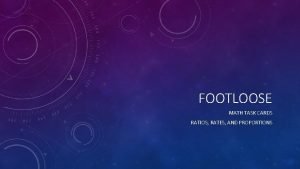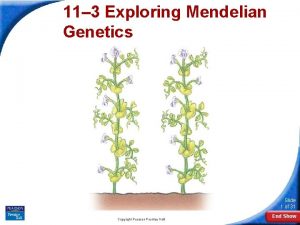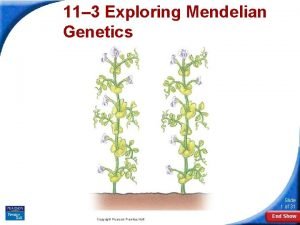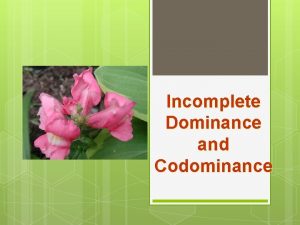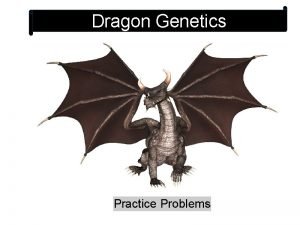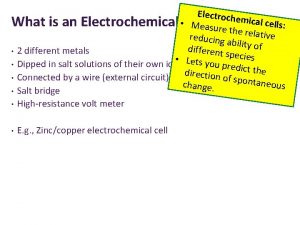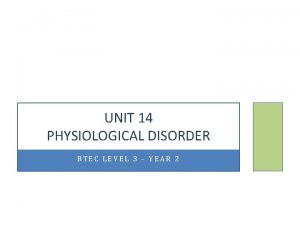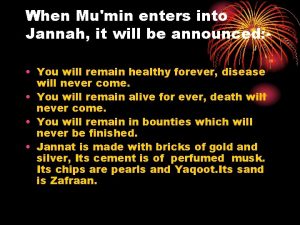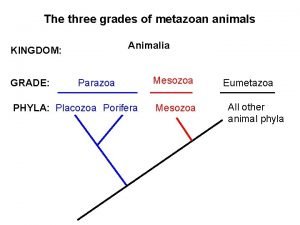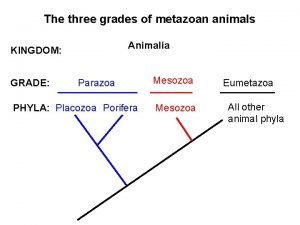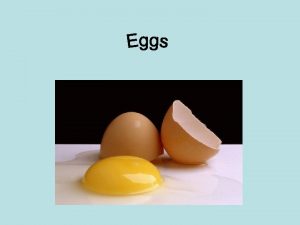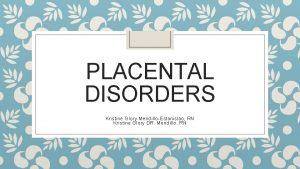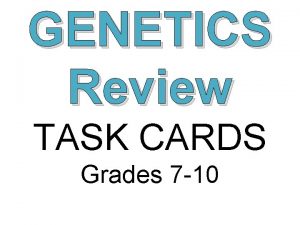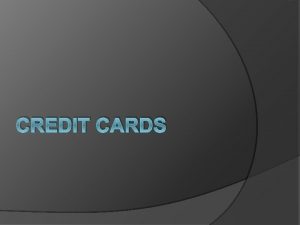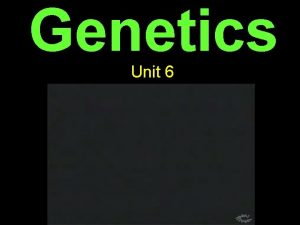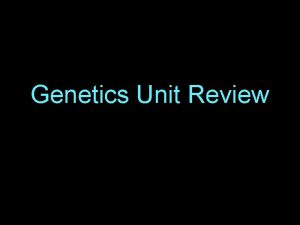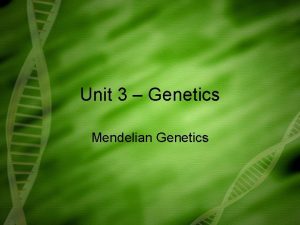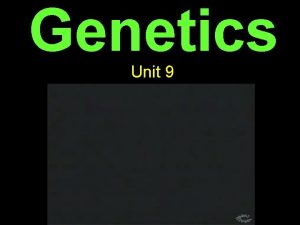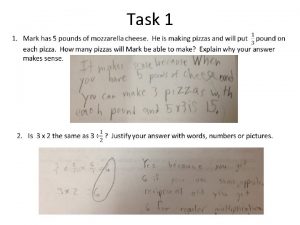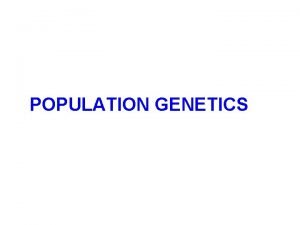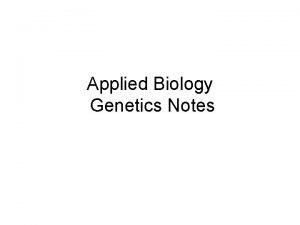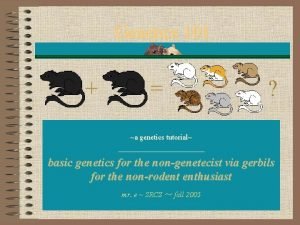GENETICS UNIT TASK CARDS Grades 7 10 ANSWERS










































- Slides: 42

GENETICS UNIT TASK CARDS Grades 7 -10 ANSWERS

1 Which of Mendel’s Laws states that the members of each pair of alleles separate when gametes are formed? Tt Mendel’s Law of Segregation T t

2 Draw a Punnett square depicting the cross of the F 1 generation of Mendel’s pea plant experiments. P P p PP Pp Pp pp

3 In Rabbits, the allele B for black hair is dominant over the allele b for brown hair. Calculate the probability of homozygous dominant offspring resulting from a cross between two heterozygous parents. B b BB Bb Bb bb The probability of having homozygous dominant offspring is ¼ or 25%

4 In horses, the allele C for a chestnut coat is is dominant to the allele c a gray coat. Calculate the probability of heterozygous offspring resulting from a cross between a heterozygous parent and a homozygous recessive parent. The probability of having heterozygous offspring is ½ or 50% C c Cc cc

5 In horses, the allele C for a chestnut coat is is dominant to the allele c a gray coat. A heterozygous stallion and a heterozygous mare have produced three chestnut foals. What is the chance that their next foal will also be chestnut? The probability of having another chestnut foal is ¾ or 75%. C CC Cc cc

6 In eggplant, the allele P for purple eggplants are dominant over the allele p for white eggplants. Calculate the probability of heterozygous offspring resulting from a cross between a homozygous dominant parent and a homozygous P P recessive parent. The probability of having heterozygous offspring is Pp Pp 100% Pp Pp p

7 In pea plants, the allele T for tall pea plants is dominant to the allele t for short plants. Calculate the probability of homozygous dominant offspring from a cross between a heterozygous parent and a homozygous recessive parent. T t The probability of having homozyous dominant offspring is 0%. Tt tt t

8 In dragons, yellow eyes are dominant to green eyes. Two yellow-eyed dragons mate, and produce three eggs. Of the three hatchlings, one has green eyes. What are the genotypes of the parent dragons? The parent dragons must be heterozygous. Y y Y YY Yy Yy yy

9 A plain spider is crossed with a patterned In Hawaiian Happy Face Spiders, spider. The patterned spider is heterozygous. the patterned allele is dominant to Which genotypes are produced among the plain allele. offspring and in what ratio? Which phenotypes are produced and in what ratio? P p The genotypic ratio of the offspring is 2: 2 heterozygous to homozygous recessive; The phenotypic ratio of the offspring is 2: 2 patterned to p plain or 50/50. Pp pp

10 In Hawaiian Happy Face Spiders, the patterned allele is dominant and the plain allele is recessive. Two patterned heterozygous spiders are crossed. 600 offspring are produced. How many of them are plain? 150 of the offspring would be predicted to be plain.

11 If you resemble one parent more than the other, does that mean that you have inherited more of your genes from that parent? Briefly explain your reasoning. No, you inherit half of your genes from each of your parents. If you resemble one parent more than the other, then you probably inherited more of that parent’s dominant traits.

12 Which Mendel’s Law states that two or more pairs of alleles segregate independently of one another during gamete formation, creating at least four different outcomes? Aa Mendel’s Law of Independent Assortment Bb A A a a B b

13 Which of Mendel’s laws does this illustration represent? Mendel’s Principle of Dominance

14 Which of Mendel’s laws does this illustration represent? Mendel’s Law of Independent Assortment

15 Which parent, mother or father, determines the gender of the child? Provide evidence using a punnett square. The father determines the gender of the child. Mothers are XX, they can only give X chromosomes to their children. The father is XY. If he gives the child an X, the child is a girl. If he gives the child a Y then the child is a boy. Mother X F a t X XX XX XY XY

16 In Alaskan malamutes, the dwarf allele is recessive (d), while the normal allele is dominant (D). Show a test cross in which all of the offspring are phenotypically dominant. D d Dd Dd

17 How many traits are being examined in this cross? Which type of cross is demonstrated in this Punnett square? Two traits -- A dihybrid cross.

18 Describe the difference in phenotypes between organisms that exhibit incomplete dominance for a trait vs. organisms that exhibit codominance for a trait. In organisms that exhibit incomplete dominance, the traits blend together like mixing paint. In organisms that exhibit codominance, the traits are both present; neither is masked by the other.

19 Hair texture typically is incompletely dominant, and can be curly (C), straight (S) or wavy (SC). Construct a Punnett square crossing a curly-haired parent with a wavyhaired parent. Determine all phenotypic ratios of the potential offspring. C C CC CS 50% of the offspring will show the hybrid trait (wavy); 50% of the offspring will have curly hair.

20 The rhododendron pictured here exhibits which of inheritance pattern for the flower petal color? Codominance.

21 A cross between a black cat and a tan cat produces a tabby pattern (black and tan fur together). List all the possible phenotypes and in what ratios from a cross between a tabby cat and a black cat. 50% of the kittens would have black fur; 50% of the kittens would have the tabby pattern. B T B BB BT

22 Plant 1 Plant 2 Plant 1 is homozygous for the chevron allele. Plant 2 is homozygous for the oval allele. The chevron and oval alleles are codominant. If plant 1 and plant 2 are crossed, the codominance of the alleles will most likely result in which of the following leaf patterns on the offspring plants? A B C D

23 In humans, there are 3 alleles for blood types: A, B and O. A and B are codominant, resulting in a third blood type, AB. The O blood type is recessive. If a man who is heterozygous for type B blood marries a woman who has type AB blood, which blood type would their child most likely be? IA IB The child would most likely be type B (with a 50% chance). i I B IAIB IBIB IAi IBi

24 In pigeons, three alleles of a single gene govern their feather color. BB= blue feathers BA= ash red feathers bb= chocolate feathers (recessive). Which complex pattern of heredity is this an example of? Multiple alleles.

25 In pigeons, three alleles of a single gene govern their feather color. BB= blue feathers (dominant) BA= ash red feathers b= chocolate feathers (recessive) Construct a Punnett square crossing a pure ash-red pigeon to a blue pigeon who also carries the recessive allele. Which percentage of the offspring could BB be expected to be ash-red? 50% of the offspring could be expected to be ash-red. b BA BBBA BAb

26 Which pattern of inheritance does the diagram illustrate? X linked inheritance.

27 • A woman who is heterozygous for hemophilia marries a healthy man (does not have hemophilia. ) What are the chances that they will have a child with hemophilia? Provide evidence using a punnet square.

28 Hemophilia is an sex linked disorder in which blood clotting proteins are severely reduced; causing excessive bleeding from minor injuries. Given that it the allele for hemophilia is present on the X chromosome, explain how you know the genotype of the father of a hemophiliac woman. Since women inherit the X chromosome from their father (as opposed to the Y), and men only have one X chromosome. Therefore, if the woman is hemophilic her father must also be hemophilic given that it is a recessive disorder.

29 In cats, the genotype XB is black, XBXO is calico, and XO is orange. The gene codominant and is located on the X chromosome, making it a sex-linked trait. If a calico female mates with a black male, what offspring would be expected? XB Xb XB Y XBXB XBXb XBY Xb Y The offspring that would be expected are black and calico females, and black and orange males.

30 In cats, the genotype XB is black, XBXO is calico, and XO is orange. The gene codominant and is located on the X chromosome, making it a sex-linked trait. Refer to card #32. Explain why there could never be any male calico cats. There can never be a calico male cat because two alleles are required. Since the alleles are X-linked, two X chromosomes are needed.

31 I. I!I. IV. Is this likely a pedigree for a dominant or recessive trait/disorder? Explain how you know using examples from the pedigree. The disorder is recessive. I-1 has the disorder, and I-2 does not; all of their children are carriers/heterozygous, but they do not have the disorder/trait.

32 I. I!I. IV. Is this likely a pedigree for a dominant or recessive trait/disorder? Explain how you know using examples from the pedigree. The disorder is dominant. One possible explanation is persons II-4 and II-5. The both have the trait but their son (person III-5) does not. If this were a recessive trait, all their children would have it.

33 In certain portions of the population, there is a lethal genetic disease called Tay Sachs disease. Tay Sachs results in destruction of the nervous system. This disease is caused by a recessive allele of a single gene. Why does this disease persist, even though it is fatal long before the afflicted individual reaches reproductive age? (in other words, why doesn’t the allele for Tay Sachs disease simply disappear? ) This disorder doesn’t disappear from the population because someone who is a carrier (heterozygous) does not have the disease but can pass it to their children. If two parents, who are heterozygous for Tay Sachs, have children, then each of their children have a 25% chance of inheriting two copies of the Tay Sachs gene and thereby having the disease.

34 The diagram shows the positions of the genes for flower color and stem length in a pea plant. The chromosomes represented below will replicate before meiosis. For these two genes, what is the maximum number of different allele combinations that can be formed normally in gametes produced from this cell? Answer: four Pt, PT, pt, p. T

35 In guinea pigs, the allele S for short hair is dominant over the allele s for long hair. Also, the allele B for black hair is dominant over the allele b for brown hair. Which ratio of offspring are expected to be short haired and brown from a cross of two guinea pigs that are both heterozygous for each trait? 3/16 of the offspring. *You may require a dihybrid Punnett square but students should be familiar with the 9: 3: 3: 1 ratio for heterozygous crosses.

36 • Explain the difference between polygenic traits and multiple alleles. Provide an example of each. Polygenic Traits: multiple genes control a single trait. This will produce a wide range or gradient of phenotypes. Examples include height & skin color. Multiple Alleles: There are multiple variations of a trait within a population. Examples include human blood types, and rabbit fur color. There are three alleles for blood type in the human population (IA, IB and i)

37 What type of genetic disease is shown below? Translocation

38 What type of genetic disease is shown below? Nondisjunction

39 Explain how to parents with achondroplasia can have a regular height child. Because achondroplasia is a dominant single gene mutation, parents must only carry 1 allele coding for the condition (be heterozygous). As such, if both parents are heterozygous, there is a 1: 4 chance (25%) that their child will be born without the condition.

40 Challenge: Do you really understand independent assortment? Try a Trihybrid! Dominant Recessive Plant Height Tall (T) Short (t) Pea Texture Round (R) Wrinkled (r) Pea Color Green (G) Yellow (g) • A pea plant with the genotype Ttrr. Gg is crossed with a pea plant with genotype tt. RRGg. • What percentage of offspring will be tall with green round peas? • Show your work on a separate piece of paper. Answer on the next slide

41 • Parent 1: Ttrr. Gg Tr. G, Trg, tr. G, trg • Parent 2: tt. RRGg t. RG, t. Rg Tr. G Trg tr. G trg t. RG Tt. Rr. Gg tt. Rr. GG tt. Rr. Gg t. Rg Tt. Rr. Gg Tt. Rrgg tt. Rr. Gg tt. Rrgg 1/8 Tt. Rr. GG 2/8 Tt. Rr. Gg 1/8 Tt. Rrgg 1/8 tt. Rr. GG 2/8 tt. Rr. Gg 1/8 tt. Rrgg 3/8 Tall with Green, Round Peas
 25x1024
25x1024 What is a source card
What is a source card Goleansixsigma
Goleansixsigma Making connections task cards
Making connections task cards Jackson task cards
Jackson task cards Proportion task cards
Proportion task cards Congruent triangles matching activity
Congruent triangles matching activity Point of view task cards
Point of view task cards Cccs weebly
Cccs weebly Quadrilateral task cards answer key
Quadrilateral task cards answer key Yield grading
Yield grading Tiered task bias task
Tiered task bias task 14-3 human molecular genetics
14-3 human molecular genetics Section 11-3 exploring mendelian genetics answers
Section 11-3 exploring mendelian genetics answers 11.3 exploring mendelian genetics
11.3 exploring mendelian genetics Homozygous example
Homozygous example Chapter 7 extending mendelian genetics study guide answers
Chapter 7 extending mendelian genetics study guide answers Dragon genetics practice problems answers
Dragon genetics practice problems answers Credit card activity worksheet
Credit card activity worksheet Unit 6 review questions
Unit 6 review questions Electroch
Electroch Task 6 equivalent or not answers
Task 6 equivalent or not answers Paper folding constructing task answers
Paper folding constructing task answers Unit 14 health and social care level 3
Unit 14 health and social care level 3 Task 1 unit 4
Task 1 unit 4 Coming out to parents letter
Coming out to parents letter Advantage of cooperation
Advantage of cooperation Unit 2 computer systems
Unit 2 computer systems Unit 11 writing
Unit 11 writing Grades of jannah
Grades of jannah Global grading system salaries
Global grading system salaries Eku dual credit
Eku dual credit Varicocele grading
Varicocele grading Ostia in porifera
Ostia in porifera Ocelli
Ocelli Grade boundaries
Grade boundaries Egg grades
Egg grades Transmutation of grades
Transmutation of grades How do pay grades work
How do pay grades work Grade and section:
Grade and section: Placenta previa grades
Placenta previa grades Mobilization grades
Mobilization grades Sniffing position intubation
Sniffing position intubation





